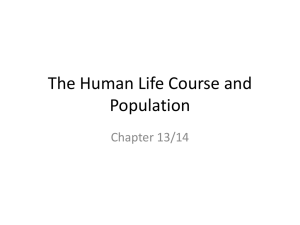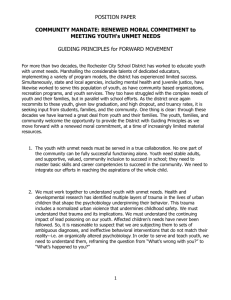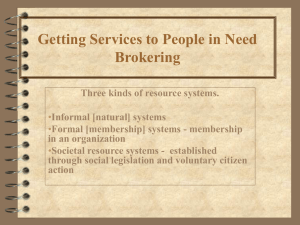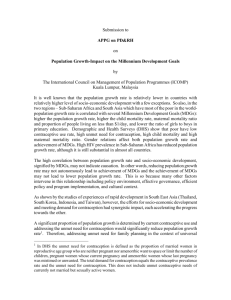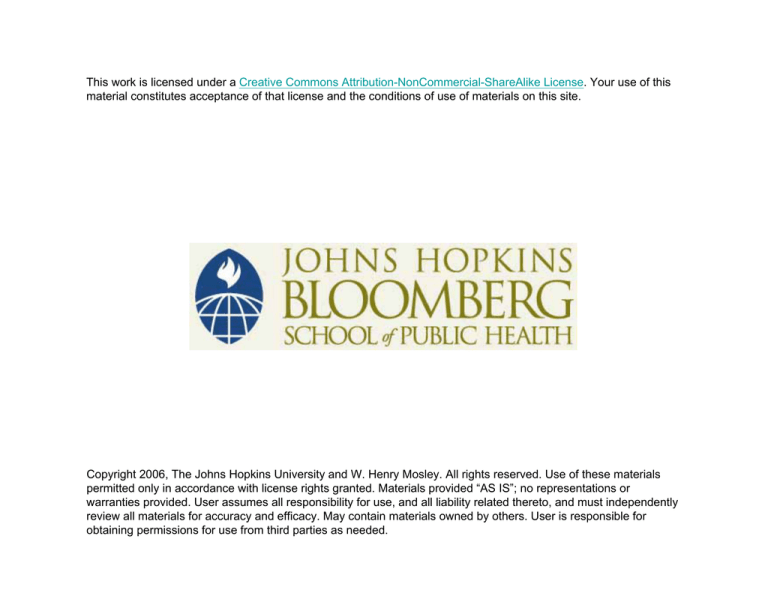
This work is licensed under a Creative Commons Attribution-NonCommercial-ShareAlike License. Your use of this
material constitutes acceptance of that license and the conditions of use of materials on this site.
Copyright 2006, The Johns Hopkins University and W. Henry Mosley. All rights reserved. Use of these materials
permitted only in accordance with license rights granted. Materials provided “AS IS”; no representations or
warranties provided. User assumes all responsibility for use, and all liability related thereto, and must independently
review all materials for accuracy and efficacy. May contain materials owned by others. User is responsible for
obtaining permissions for use from third parties as needed.
PFHS-380.665 FAMILY PLANNING POLICIES AND PROGRAMS
Demand-Supply Framework for Family Planning Program Analysis and Unmet
Need for Contraception
W. Henry Mosley
A.
Supply of, and demand for children with socio-economic development
(Easterlin model)
1.
Demand = number of surviving children parents would have if fertility regulations
were costless.
2.
Supply = number of surviving children couples would have if they made no
deliberate attempt to limit family size.
3.
Cost of fertility regulation = economic, psychic, health and social costs of
acquiring and using contraception and abortion.
B.
Demographic indicators of the demand-supply framework
1.
limitation .
Contraceptive prevalence as a measure of “met” demand for fertility
2.
Unmet need for family planning measured as proportion of women in a
sexual union desiring to space or limit childbearing and not using contraception
3.
Total potential demand for family limitation measured by contraceptive use
plus unmet need.
4.
Latent demand (for controlling childbearing) measured as difference
between achieved fertility and desired fertility, or as level of unintended, or unwanted
childbearing.
5.
Overt demand for controlling childbearing as measured by the total
abortion rate
C.
Unmet need for family planning
The unmet need group includes all fecund women who are married or living in union and thus presumed to be sexually active - who are not using any method of
contraception and who either do not want to have any more children or who want to
postpone their next birth for at least two more years.
The unmet need group also includes all pregnant married women, and women who
have recently given birth and are still amenorrheaic if their pregnancies/births are
unwanted or mistimed because they were not using contraception.
1
D.
Levels and trends in unmet need
Changing patterns with declines in desire for children and with increasing levels of
contraceptive prevalence. Unmet need is highest in the early post-partum period and
falls as the time since last birth gets longer.
E.
Expanded formulations of unmet need
1. As it relates to contraceptive methods:
2.
F.
-
using ineffective methods
-
using an effective method incorrectly
-
using a method that is unsafe or unsuitable for them
As it relates to risk groups:
-
unmarried women
-
sexually active youth
-
separated, divorced, widowed
Reasons for unmet need
1. Provider constraints
Limited access to services
Medical barriers
Quality of care
2. Client constraints
Lack of information
Health concerns
Opposition from family and community
Ambivalence
G. Intention to Use a Method
Intention to use a contraceptive method in the future is also measured in the
DHS surveys based on women's own statements. Not all women with an "unmet need"
express and intention to use in the future (for reasons given above), while many women
who do not have an unmet need will express and intention to use in the future. In fact,
the women without an unmet need who intend to use outnumber the women with an
unmet need who intend to use in many countries. (Ross and Heaton, 1997). This
"discrepancy" relates to the procedure for defining unmet need.
H. Implications of unmet need for family planning
2
References
Required:
Stash, S. Explanations for unmet need for contraception in Chitwan, Nepal.
Studies in Family Planning 30 (4): 267-287, 1999.
Westoff, CF and Bankole, A. Trends in the demand for family limitation in
developing countries. International Family Planning Perspectives 26 (2):
56-62, 2000.
Reference:
Casterline, JB and Sinding, S. Unmet need for family planning in developing
countries and implications for population policy. Population and
Development Review 26: 691-723, 2000.
Recommended Reading:
Bongaarts, J. The supply-demand framework for the determinants of fertility: an
alternative implementation, Population Studies 47:437-456, 1993.
Bongaarts, J and Bruce, J . The causes of unmet need for contraception and the social
content of services. Studies in Family Planning 26(2):57-75, 1995.
Ross, J. Commentary. The question of access. Studies in Family Planning
26(4):241-2, 1995.
Bongaarts, J, and Bruce, J. Question of access: Response. Studies in Family
Planning 26(4):243-244, 1995.
Casterline, JB, El-Zanaty, F, and El-Zeini, LO. Unmet need and unintended fertility:
longitudinal evidence from upper Egypt. International Family Planning
Perspectives 29 (4): 158-166, 2003.
Casterline, JB, Sathar, ZA, and Haque, M ul. Obstacles to contraceptive use in
Pakistan: a study in Punjab. Studies in Family Planning 32(2):95-110, 2001.
Casterline, J, Perez, AE, and Biddlecom, AE. Factors underlying unmet need for family
planning in the Philippines. Studies in Family Planning 28(3):173-191, 1997.
Donaldson PJ and Tsui AO. The international family planning movement. Population
Bulletin 45(3), November 1990.
Feyisetan, B and Casterline, JB. Fertility preferences and contraceptive change in
developing countries. International Family Planning Perspectives 26 (3):100-108,
2000.
Hakim, C. A new approach to explaining fertility patterns: preference theory.
Population and Development Review 29 (3): 349-374, 2003.
Jain, A. Should eliminating unmet need be a program priority? International Family
Planning Perspectives 25 (Supplement): 539-543, 1999.
3
Lapham Robert J and Simmons George B. Overview and Framework. Chapter 1
(pp.3-34) in RJ Lapham and GB Simmons (eds) Organizing for Effective Family
Planning Programs. Washington, D.C.: National Academy Press, 1987.
Legrand, T, Koppenhaver, T, Mandain, N, and Randall, S. Reassessing the insurance
effect: a qualitative analysis of fertility behavior in Senegal and Zimbabwe.
Population and Development Review 29 (3) 375-403, 2003.
Lesthaeghe, R and Vanderhoeft, C. Ready, willing, and able: a conceptualization of
transitions to new behavioral forms. Chapter 8 in: John B Casterline, ed:
Diffusion Process and Fertility Transition. Selected Perspectives. Washington,
DC, National Academy Press, 2001.
http://books.nap.edu/books/0309076102/html/240.html#pagetop
Lindstrom DP. The role of contraceptive supply and demand in Mexican fertility decline:
evidence from a microdemographic study. Population Studies 52: 255-274,
1998.
Phillips JF, Ross JA. Family Planning Programs and Fertility Effects: An Overview.
Chapter 16, pages 325-331 in JF Phillips and JA Ross (eds) Family Planning
Programs and Fertility. Oxford: Clarendon Press, 1992.
Robey, B, Ross, J, and Bushan, I. Meeting Unmet Need: New Strategies. Population
Reports, Series J, No.43, Baltimore, Johns Hopkins School of Public Health,
Population Information Program, September, 1996.
Robinson, W and Cleland, J. The influence of contraceptive costs on the demand for
children. Pages 106-22, in: JF Phillips and JA Ross (eds), Family Planning
Programs and Fertility, New York,: Clarendon Press, Oxford, 1992.
Ross, JA and Heaton, L. Intended contraceptive use among women without an unmet
need. International Family Planning Perspectives 23 (4):149-154, 1997
Ross, J, Stover, J and Willard, A. Profiles for Family Planning and Reproductive Health
Programs. 116 Countries. The Futures Group International, Glaxtonbury,
Connecticut, 1999.
Ross, JA and Winfrey, WL. Contraceptive use, intention to use and unmet need during
the extended postpartum period. International Family Planning Perspectives
27(1):20-27, 2001
Ross, JA and Winfrey, WL. Unmet need for contraception in the developing world and
the former Soviet Union: an updated estimate. International Family Planning
Perspectives 28: 138 – 143, 2002.
Roy, TK, Nangla, P, Saha, U, and Khan, N. Can women’s childbearing and
contraceptive intentions predict contraceptive demand? Findings from a
longitudinal study in central India. International Family Planning Perspectives 29
(1): 25-31, 2003
Shelton, JD, Bradshaw L, Hussein, B, Zubair Z, Drexler T, and McKenna, MR. Putting
unmet need to the test: community-based distribution of family planning in
Pakistan. International Family Planning Perspectives 25 (4): 191-195, 1999.
4
Sinding, SW, Ross, JA, Rosenfield, AG. Seeking common ground: Unmet need and
demographic goals. International Family Planning Perspectives 20(1): 23-27,
1994.
Westoff, CE, and Bankole, A. The potential demographic significance of unmet need.
International Family Planning Perspectives 22(1):16-20, 1996.
Westoff, CF and Bankole, A. The time dynamics of unmet need: and example from
Morocco. International Family Planning Perspectives 24 (1): 12-14, 1998.
5


